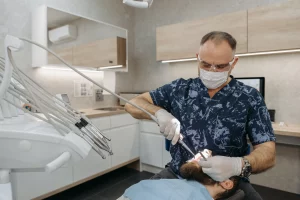The dental profession is a versatile career that offers many rewarding career opportunities. This field encompasses many different roles, including private dental practice, hospital dental care, and dental specialists. Dentists are amongst the top 15 per cent of global earners. They also enjoy a high social standing within their respective communities. They are in high demand due to their high levels of skill and creativity, making them a desirable choice for those who want to help people.
Dental hygienist takes photographs of teeth
A dental hygienist can be described as a medical professional who performs many procedures. They take pictures of your teeth, chart decay, and monitor the health of your gums. They may also take xrays of your teeth. This can reveal issues such as oral cancer or dentist jeddah decay. They also review the images and work with a dentist to develop them. A general procedure that the dental hygienist might perform is to check the health of the mouth, chart decay, and take a look at the cavity.

To take photos of your teeth, the dentist assistant must dry the area. The dental assistant should also provide suction, since mirrors can fog up. The technique for taking a dental x-ray can be found in Table 2. The dentist may also capture additional views based on clinical findings and practitioner preference. Additional photographic tips are listed in Table 3.
Dentists receive X-rays
X-rays, which are commonly used in dental offices, are a common procedure. They help dentists diagnose dental issues such as cavities and impacted teeth, as well as monitor the growth of your adult teeth. Xrays can also be used by dentists to check for missing teeth and if the gums have not opened. Depending on what the problem is, dentists can take several types X-rays during a routine appointment.
X-rays of the dental mouth are typically taken once a calendar year. However some dentists recommend more frequent appointments if you have a history with tooth decay, gum disease or any other oral condition. X-rays can also be used to assess the health of the roots and nerves. Children may require more frequent x-rays than adults. Nonetheless, regular dental visits will help your dentist detect problems early on.
Dentists fill cavities
Nearly every tooth is at risk for developing a cavity in their lifetime. Cavities develop when the enamel begins to fall apart and bacteria remains on the tooth. To restore the tooth’s function, a dentist fills cavities using amalgam. A dentist will first take an Xray of the tooth to complete this procedure. This will determine the best treatment plan and the extent of damage. If necessary, the dentist will drill down into the tooth to extract the decayed material and then fill the hole with amalgam. The dentist may also inject a local anesthetic to make the work easier.
A cavity can be filled in the same manner as an adult tooth but the procedure is slightly different. First, the dentist will clean the cavity. Next, the dentist will fill the cavity using either metal or composite material. Finally, it will be attached to the tooth. This procedure is generally painful. A local anesthetic is used to anesthetize the area. To help children relax, nitrous oxide may be administered. For younger children, however, nitrous oxide should not be used.
Dentists remove tooth decay
Brushing and flossing regularly is the best way to prevent tooth decay. Fluoride treatments can also help the enamel repair itself. A root canal is also known as a filling. It restores decayed tooth tissue and prevents further damage. Sometimes, the dentist may need to remove the tooth pulp. This contains nerve endings and blood. Once this pulp has been removed, the tooth can be filled with a temporary filling or a crown.
A professional dentist can also apply fluoride treatments to strengthen the tooth enamel. Fluoride treatments are available at the dentist’s offices and can be very effective in preventing tooth decay. Fluoride, a mineral that strengthens enamel can make a cavity disappear. Fluoride treatments are painless, and require little recovery time. The procedure can be performed by your dentist in just one visit.
Oral diseases are diagnosed by dentists
Dentists are trained in recognizing signs and symptoms of common oral diseases. In many cases these symptoms are a sign of a developing disease. Your dentist will examine your mouth for signs of disease. Overgrowth of yeast in the mouth may also be an indication of an autoimmune disease, such as HIV or leukemia. Sometimes, a dental appointment can prevent serious dental problems, such as tooth decay.
While dentists can diagnose a wide range oral diseases, some rarer conditions should be treated as a separate entity. For instance, burning mouth syndrome (BMS) is a rare disorder that primarily affects postmenopausal women. Although the cause of BMS remains unknown, many BMS sufferers also have psychogenic conditions. Therefore, it is important to be sure of a dentist’s diagnosis and avoid relying on incomplete information provided by a general practitioner.
Dentists treat oral cancer
There are many steps involved in treating oral cancer. This includes a thorough exam as well as the removal of suspicious growths. The process includes xrays, blood tests, as well as a biopsy. The patient’s biopsy is sent to a laboratory for testing. It is important to visit a dentist regularly if the patient has any signs of oral cancer.
It is important that you know that only dentists are qualified to treat your oral cancer. While oral cancer is generally considered to be relatively benign, it can still prove fatal. However, early detection is the key to minimizing the risk of oral cancer death. Dental professionals have the best chance to raise awareness and reduce the death rate. They can also help patients and promote healthy mouth habits. Although it can be difficult to talk about oral cancer and risk factors, the information in this article will make it easier for everyone.
